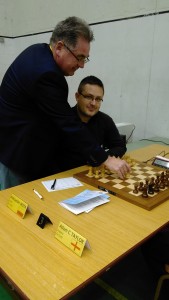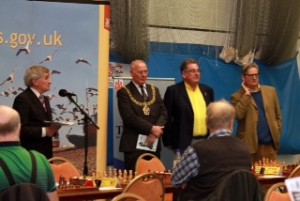— from Mark Jordan, ECF Publicity Manager
The 91st Hastings International Chess Congress opened on Monday 28 December 2015 at Horntye Park Sports Complex, and now two rounds have been completed in the Masters event. Cllr Bruce Dowling welcomed players to Hastings from around 20 countries, including Trinidad and Tobago, Argentina and Australia. A welcome also came from Dominic Lawson, President of the English Chess Federation and Paul Smith, Chairman of Hastings Chess Congress.


[above] Wayne Bradshaw of Tradewise UK making the opening move for GM Alex Mista, and Paul Smith (Chairman, HICC), Bruce Dowling (Mayor of Hastings), Wayne Bradshaw (Marketing Director, Tradewise Insurance) and Dominic Lawson (President, ECF) at the Opening
This year sees the introduction of a new sponsor, Tradewise Insurance Services, a subsidiary of Tradewise Insurance, Gibraltar, who sponsor the very successful Gibraltar Chess Festival and who were represented by the Marketing Director of Tradewise, Wayne Bradshaw. Mr Bradshaw said Tradewise were pleased to be involved with the Hastings Congress and look forward to future events. The company is keen revive the fortunes of the Hastings Congress and encourage chess players, in particular younger players, to compete and reach their potential. Tradewise are joint sponsors with Hastings Borough Council to whom we owe thanks for their longstanding support. Additional support comes from The White Rock Hotel, The Lansdowne Hotel, and KC Computers.
Spectators are welcome at the event and there is a live commentary each day given by English Grandmaster Chris Ward – entry to this and the main event is free. Masters games begin each day at 14.15 and the commentary starts at 14.45.
The first round of the Masters began promptly at 2.15 after the opening ceremony. The favourite this year is GM Berkes 2650 followed by GM Khenkin 2605 and then GM Mista 2567. Leading the English challenge are GMs Gormally 2506, Arkell 2490, Hebden 2469, Flear 2459 and Williams 2439. A particularly welcome participant in the Masters event is the legendary Russian GM, Oleg Romanishin 2462, who won Hastings in 1976 and the congress welcomed back many regular visitors to Hastings as well as a good few newcomers.
Being a seeded Swiss tournament, round 1 saw the top half of the table playing the bottom and thus, as usual, there was the potential for upsets. The stars on the top 5 boards escaped unscathed with the first surprise coming on board 6 where the experienced English player, John Anderson 2247, playing White, managed to hold GM Sulskis 2535 to a draw. Not such good news for the English contingent was GM Arkell drawing with White against Rolvag 2221 on Board 9 and the main upset of the day came on Board 12 where GM Flear lost with the Black pieces to FM Robin Cunningham 2205. Romanishin, on Board 11, started well, despatching English FM David Ledger 2212.
Round 2 saw the favourites already facing challenging opposition and this was reflected in the results. On Board 1 English GM, Simon Williams, drew with tournament favourite, Berkes, and on Board 2 IM Bagi 2440, held second favourite Khenkin to a draw with the Black pieces. On Board 6 Cunningham, having beaten a GM in Round 1, drew with another GM, Gormally, in round 2 and will presumably be very happy with his start. The first real upset was Hebden’s loss with the White pieces to the young FM Karthik 2310.
With a number of draws on the higher Boards in round 2 we find only 5 players on 100% going in to Round 3 among who are GMs Mista, Vakhidov 2546 and Fodor 2492. FM Karthik, having beaten Hebden in the previous round joins them with, really very surprisingly, South African junior, Paul Gluckman, despite meeting quite challenging opposition. He has an FM title, by winning his age group in the African Championships, but is currently rated a very lowly 1742 (!) and has never been rated much higher than this. He will certainly be tested today as he plays Black against tournament favourite, Berkes, on Board 3.
As well as the Masters event there are also shorter tournaments for more casual enthusiasts and there is also a Weekend Congress which runs from the evening of Friday 1 January 2016 to Sunday evening. There will be a Blitz event at the White Rock Hotel on 4th January 20.30 hrs. Further information from the Congress Office at Horntye Park Tel: 0758 214 9239 Email: pae123@aol.com
Games from Round 2 annotated by Jack Rudd
(4) Norinkeviciute,Rasa (2036) – Arkell,Keith C (2490) [A10]
Tradewise Hastings Masters 15-16 Hastings, England (2.12), 29.12.2015
[Rudd, Jack]
1.c4 b6 2.Nc3 Bb7 3.e4 e6 4.Nge2 d6 5.d3 Nd7 6.g3 g6 7.Bg2 Bg7 8.Be3 Ne7 9.Qd2 h6 10.0-0 a6
Black has set up in the so-called “Hippopotamus” formation. It’s flexible, but not perhaps best against white’s setup here.11.f4 Rb8 12.Rab1 [12.d4 , with a Four Pawns Attack structure, may be better. The point of this is that it then makes it very difficult for black to get any of the standard central pawn breaks in safely.] 12…Ba8 13.b4 0-0 14.f5?! Very tempting, but in practice it seems to give away white’s advantage. The white f-pawn is more useful in these positions than the black h-pawn. 14…exf5 15.Bxh6 Ne5 16.Bxg7 Kxg7 17.exf5 Nxf5 18.Nd5 c6 19.Ndc3 Rh8
20.Rxf5!? Maybe not objectively sound, but trying to mix it against a stronger player is often a good practical tactic. 20…gxf5 21.Nd4 Rh5 22.Rf1 Qf6 23.Ne4? [23.Qf4 is the computer’s recommendation, although defending 23…Nxd3 24.Nxf5+ Rxf5 25.Qxf5 Qxf5 26.Rxf5 Nxb4 against Keith Arkell would be a miserable task in practice.] 23…Qg6 24.Nc3 c5 Black’s pieces all come into the game, and the extra exchange tells. 25.Nc2 Bxg2 26.Qxg2 Rbh8 27.h4 Nxd3 28.Nd5
28…f4! Forcing a transposition into a winning ending. 29.Nxf4 Nxf4 30.Rxf4 Rf5 31.Re4 Re5 32.Rxe5 dxe5 33.bxc5 bxc5 34.Ne3 Rb8 35.Qf3 e4 36.Qf4
36…Rb6 [Fritz thinks black should have been greedier here: 36…Rb1+ 37.Kg2 Rb2+ 38.Kh3 Rxa2 39.Ng4 Rc2 40.Qe5+ f6 41.Qxc5 Qf7] 37.Nf5+ Kh7 38.g4 [38.Qxe4 Rb2 is similarly unpleasant for white.] 38…Qf6 39.g5 Rb1+ 40.Kg2 Qb2+ 41.Qf2 Qxf2+[41…Qa3 42.Ng3 Rb2 43.Ne2 Kg8 is faster, but the text is sure enough.] 42.Kxf2 Rb2+ 43.Ke3 Rxa2 44.Kxe4 Rd2 45.h5
45…a5 This pawn will win the knight and the game. 46.Ne3 a4 47.Nd5 a3 48.Nc3 a2 49.Nxa2 Rxa2 50.g6+ Kg7 51.gxf7 Rh2 52.Kd5 Rxh5+ 53.Ke6 Kf8 0-1
(5) Rudd,Jack (2255) – Brewer,Callum D (1945) [E11]
Tradewise Hastings Masters 15-16 Hastings, England (2.21), 29.12.2015
[Rudd, Jack]
1.d4 Nf6 2.c4 e6 3.Nf3 Bb4+ 4.Bd2 a5 5.Nc3 b6 6.e3 Bb7 7.Bd3
7…d6 [7…Bxc3 8.Bxc3 Ne4 is an alternative way to play this, which I thought was better than the text. In the actual game, I gain control of e4 very easily.] 8.Qc2 Nbd7 9.0-0-0 Qe7 10.e4 0-0-0 [10…h6!? is an idea, waiting for white to commit himself first. 11.h3 is probably a psychologically accurate counter.] 11.Rhe1
11…Bxc3 A minor concession, but the position is already difficult. The three standard pawn breaks, …c5, …d5 and …e5 all come with problems attached. 12.Bxc3 e5 13.d5! This one took Brewer by surprise. I, on the other hand, was more than happy to go into a King’s Indian structure. After all, the a3-b4-c5 idea has gained in force somewhat from the position of black’s king… 13…Nc5 14.Bf1Declining to swap off the “bad” bishop looks odd, but, as they say, bad bishops protect good pawns. They also become very good bishops if the pawn-breaks come in. 14…g6 [14…Nfxe4 15.Rxe4 Nxe4 16.Qxe4 is something both of us briefly looked at, but neither of us thought it gave black much joy.] 15.b3 Kd7 Attempting to run away to a safer home on g7… 16.a3 a4 17.b4 Nb3+ 18.Kb2 Ra8
19.c5! …but he isn’t going to get there. 19…bxc5 20.Bb5+ Kd8 21.bxc5 [21.Bxa4 Nd4 is a line I rejected over the board, but Fritz seems to think it’s quite nice for white: 22.Bxd4 cxd4 23.Bb5] 21…Nxc5 22.Nxe5 dxe5 [22…Rb8 is another possible defence, but white can keep the advantage with careful play: 23.Ka2 dxe5 24.Bb4 Nfd7 (24…Bxd5+ 25.Rxd5+ Nxd5 26.Bxc5) 25.Bxd7 Qxd7 26.Qxc5] 23.Bb4 Nfd7 24.Bxd7 Qxd7 25.Qxc5
It is said that, with opposite coloured bishops, the side with the attack is always winning, and this is certainly the case here. A black-squared bishop would at least have given black some chances of defending the weak pawns on c7 and f6.25…Ra6 26.f4 Re8 27.Ba5 Kc8 28.Rc1 Rxa5 Desperately trying to stir things up in time-trouble. 29.Qxa5 exf4 30.Rc4 Re7 31.Rec1 Qd6 32.Qxa4 g5 33.Qa7Rounding up the bishop is the clearest way to end the game. 33…f3 34.gxf3 Qxh2+ 35.R1c2 Qe5+ 36.Ka2 Qd6 37.Rb4 Ba6 38.Rb6 1-0
(6) Golding,James (1882) – Singh,Vishnu (2180) [E14]
Tradewise Hastings Masters 15-16 Hastings, England (2.31), 29.12.2015
[Rudd, Jack]
1.d4 Nf6 2.c4 e6 3.Nf3 b6 4.e3 Bb7 5.Bd3 Be7 6.0-0 0-0 7.Nbd2 d5 8.b3 Nbd7 9.Bb2 c5 10.Rc1 Rc8 11.Qe2 Qc7 12.Ne5 Ne4 13.Nxd7 Qxd7 14.Rfd1 Nxd2 15.Rxd2 Bf6 16.Ba3
16…Rfd8? 17.dxc5 Qe7 [17…bxc5 18.cxd5 Qxd5 had presumably been black’s idea, and he only realized now that it fell into 19.Bxh7+] 18.cxd5 Bxd5 19.Rdc2 bxc5 20.Bxc5 White is now a clear pawn up, although it will still take some work to convert.20…Qd7 21.Bb5
21…Bc6 Black does not want to allow further exchanges, but he has no choice: [21…Qb7 22.Ba6; 21…Qc7 22.Be7!] 22.Bxc6 Rxc6 23.h3 Be5 24.b4 h6 25.a4 Rc7 26.b5 Qd5 27.a5 Rcd7 [27…Rdc8 28.e4 also allows the b-pawn to push onwards.] 28.g3 Qb3 29.b6 axb6 30.Bxb6 Rb8 31.Rc8+ Rxc8 32.Rxc8+ Kh7
33.Qc2+ The ending with the outside passed pawn is easily winning; the bishop will guarantee that. 33…Qxc2 34.Rxc2 Rd1+ 35.Kg2 Ra1 36.Kf3 Ra3 37.Rc8 Bd6 38.Ra8 Bb4 39.a6 Ba5 After any other move, white will just play a7 and move the rook. 40.Bc5 Rc3
41.a7! Rxc5 42.Re8 With a new queen appearing, the rest is trivial. 42…Be1 43.a8Q Rf5+ 44.Ke2 Bxf2 45.Rh8+ Kg6 46.Qe4 Bxg3 47.Rc8 Kf6 48.Rc1 Rf2+ 49.Kd3 Rf5 50.Qg2 Rd5+ 51.Ke2 Be5 52.Rd1 Rb5 53.Qf2+ Ke7 54.Qh4+ f6 55.Qg4 f5 56.Qh4+ Bf6 57.Qc4 Re5 58.Qc7+ Kf8 1-0
